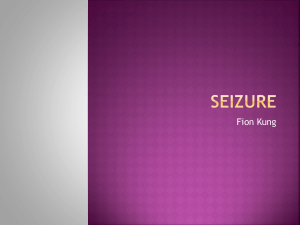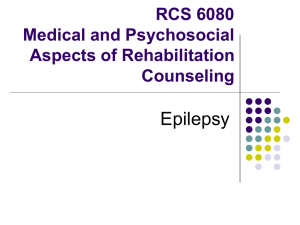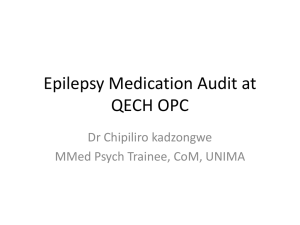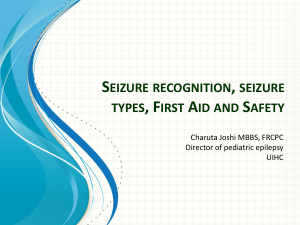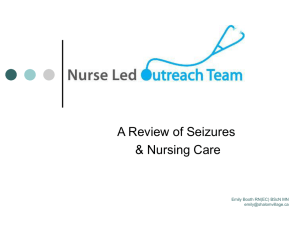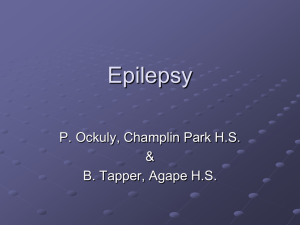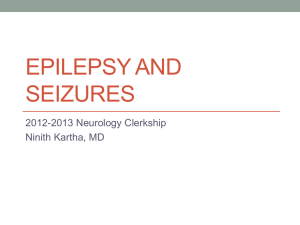Seizures - The Center for Life Enrichment
advertisement
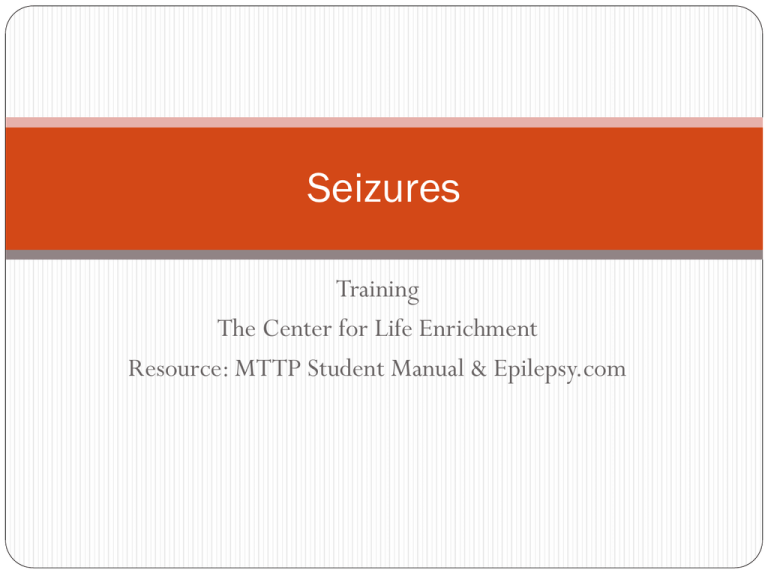
Seizures Training The Center for Life Enrichment Resource: MTTP Student Manual & Epilepsy.com What is a Seizure? A seizure is a sudden disruption of the brain’s normal electrical activity In some cases, a seizure can cause a loss of consciousness and make the body twitch and jerk People who have a repetitive pattern of seizure activity have a condition called epilepsy A large percentage of individuals with developmental disabilities have epilepsy There are more than 40 different seizure disorders What to look for? The symptoms of a seizure depend upon the area of the brain affected For example, if the abnormal electrical discharge affects only a very small area of the brain, the individual might simply experience the symptom of an odd smell or taste When large areas of the brain are involved, signs are more noticeable. The person may jerk and have muscle spasms, known as convulsions Seizures may also cause a loss of consciousness or altered consciousness, a loss of bladder control and confusion Most seizures last from 2-5 minutes and leave the person feeling tired and confused The individual may complain of a headache and sore muscles Most people cannot recall what happened during the seizure Types of Seizures There are over 40 different types of seizures. Some of the more common types of seizures include: Febrile Seizures: associated with high fevers and occur in about 4% of children up to 5 years of age Simple Partial Seizures: isolated to a small area of the brain and is not associated with an impairment in consciousness Jacksonian Seizures: begin in an isolated part of the body and then progressively spread or “march” to other parts of the body on the same side. A Jacksonian seizure may become generalized Complex Partial Seizures (Psychomotor Seizures): impairment in consciousness and usually lasts 2-4 minutes. The individual appears to lose touch with his/her surroundings and becomes confused. He/she may demonstrate repetitive or meaningless behaviors (e.g. aimless arm or leg movements, utterances of meaningless sounds, etc.). Mild confusion will remain immediately following the seizure Types of Seizures Continued… Generalized Tonic-Clonic Seizures (Grand Mal Seizures): the electrical malfunctions in the brain quickly spread to adjoining parts of the brain and the entire brain malfunctions. It is characterized by the sudden onset of muscle tensing and is often associated with an audible cry or moan. The individual loses consciousness and may fall. The muscle tensing changes to muscle contractions which cause jerking movements or convulsions. The individual often turns his/her head to one side, clenches his/her teeth, and loses bladder control. The seizure usually lasts less than 3 minutes. If it lasts 5 full minutes or longer, 911 should be called. An exception would be if the neurologist writes an order/protocol for the individual with different parameters for calling 911.When the seizure is over, the person may initially be confused and extremely tired Three or more Tonic-Clonic Seizures in a row without full recovery in between is a 911 medical emergency because the person’s breathing is affected. Emergency treatment is needed to stop the seizure activity and prevent permanent damage or death Types of Seizures Continued… Absence Seizures (Petit Mal Seizures): absence seizures are generalized with sudden loss and regaining of consciousness and no aura or warning. It is characterized by impairment of the level of consciousness which may cause confusion, diminished awareness of the environment, inability to respond to stimuli, and amnesia. They are not associated with convulsive movements. The presentation may include staring, fluttering of the eyelids, or facial muscle twitching. Absence seizures rarely last longer than 30 seconds and are usually 1-10 seconds in duration. Though brief, these seizures may occur as frequently as 100+ times per day. The seizure ends as suddenly as it began and the individual resumes his/her activity, completely unaware of what has happened Individual/Caregiver Responsibilities The individual/caregiver should know: A person with a seizure disorder should wear a medical bracelet or necklace that identifies the disorder and any medications taken Seizure control can be enhanced by following a healthy diet, getting plenty of sleep and keeping stress levels to a minimum. Since fever can trigger seizures, take medication to lower fever at the first sign of illness If the individual’s seizures begin with an aura (a sensation that precedes the onset of a seizure), he/she should get to a safe place and lie down until the seizure passes If a seizure occurs, what to do An individual can be protected from injuries that can cause seizures by wearing a helmet when riding a bicycle, skateboard, or motorcycle, or when playing certain sports, and wearing a seat belt when riding in a motor vehicle First Aid for Seizures 1. Stay calm, most seizures only last a few minutes 2. Prevent injury by moving any nearby objects out of the way 3. Pay attention to the length of the seizure 4. Make the person as comfortable as possible 5. Keep onlookers away 6. Do not hold the person down 7. Do not put anything in the person’s mouth 8. Do not give the person water, pills, or food until the person is fully alert 9. If the seizure continues for longer than five minutes, call 911. An exception would be if the neurologist writes an order/protocol for the individual with different parameters for calling 911 10. Be sensitive and supportive, and ask others to do the same Epilepsy Foundation’s Recommendations: If there is no specific protocol from the HCP, follow the Epilepsy’s Foundations recommendation for “when to call for an ambulance” No need to call an ambulance if… Medical I.D. jewelry or card says “epilepsy” And The seizure ends in under five minutes And Consciousness returns without further incident And There are no signs of injury, physical distress, or pregnancy Epilepsy Foundation’s Recommendations Continued: An ambulance should be called if… The seizure has happened in water There’s no medical I.D. and no way of knowing whether the seizure is caused by epilepsy The person is pregnant, injured, or diabetic The seizure continues for more than five minutes. An exception would be if the neurologist writes an order/protocol for the individual with different parameters for calling 911 A second seizure starts shortly after the first has ended Consciousness does not start to return after the shaking has stopped If the ambulance arrives after consciousness has returned, the person should be asked whether the seizure was associated with epilepsy and whether emergency room care is wanted Documentation of Seizures Observe all seizure activity carefully and record the information accurately This record should be shared with the supervisor, delegating nurse, residential provider/family, and the individual’s neurologist/HCP Staff’s accuracy in reporting seizure activity is critical in providing the HCP with information necessary to prescribe an appropriate treatment plan Be alert to any changes the individual may show from his/her “usual pattern” of seizure activity. Report these changes to your supervisor and delegating nurse immediately A seizure record must be maintained on all developmentally disabled individuals who receive anticonvulsant medication(s) for the treatment of seizures Discontinuation of a Seizure Record for a DD individual who is “seizure free” but continues to receive anticonvulsant medication(s) should be reviewed by the team for appropriateness and parameters for reinstituting documentation should be outlined Anticonvulsant Medications Anticonvulsant medications are used to control recurrent seizures known as epilepsy/seizure disorder Anticonvulsants do not cure epilepsy Individuals on anticonvulsant medication must see their doctor regularly for blood tests to monitor drug level in the bloodstream and to monitor for any side effects. Side effects that should be reported to the RN CM/DN and doctor include: Sluggishness Dizziness Hyperactivity Uncontrolled eye movements Speech or vision problems Nausea or vomiting Problems sleeping Most Commonly Used Anticonvulsant Medications Carbamazepine (Tegretol, Carbatrol) Phenobarbital (Phenobarbital, Luminal) Phenytoin (Dilantin) Primidone (Mysoline) Valproic Acid (Depakene) Divalproex Sodium (Depakote) Tiagabine (Gabitril) Levetiracetam (Keppra) Clonzepam (Klonopin) Lamotrigine (Lamictal) Gabapentin (Neurontin) Topiramate (Topamax) Oxcarbazepine (Trileptal) Zonisamide (Zonegran) Seizure Charting On the front of the Seizure Observation Record, observe all seizure activity carefully and record the information accurately On the back of the Seizure Observation Record, write a comment in the spaces provided if any of the check marks on the front of the Record need further explanation. If you have reported the observed seizure activity to your supervisor, RN CM/DN, or HCP, document this in the note/comment section of the Record Questions?

